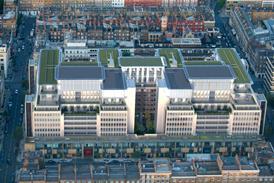
Sponsored by BSI, this module will guide professionals looking to improve their BIM knowledge, as well as assist seasoned users wanting to enhance digital security or understand the higher-level benefits of BIM adoption

BIM (building information modelling) is transforming the delivery of design, construction and asset management within the built environment. It represents the future of construction, and its global adoption is accelerating rapidly.
The digital information management process – which has collaboration and communication at its core – helps to deliver greater efficiencies by strengthening alignment and facilitating more accurate decision-making.
Like any methodology and process, BIM lives and evolves alongside the market it serves. As new technology emerges and scrutiny over information security increases, best practices and standards surrounding BIM are also evolving.
Whether you are in the early stages of your BIM journey and want to understand the benefits of adoption or an experienced BIM user looking for inspiration on how BIM can improve your organisation and unite business and societal interests, this module will provide you with the latest in BIM thinking.
Learning objectives
- Understand the role of BIM in the built environment and the benefits it brings to the sector.
- Learn about the key problems BIM addresses and the increasingly complex landscape around digital security.
- Gain awareness of relevant industry standards and independent certification available.
The core aim of BIM is to best realise an asset’s value and potential. It achieves this by clearly defining your information requirements and then managing the building information throughout an asset’s lifecycle. BIM uses a shared digital representation of an asset to strengthen collaboration and facilitate design, construction and operation processes. This forms a reliable basis for decision-making.
BIM is not a single tool or software. It is a better way of designing, building and operating assets, enabled by technology. Fundamentally, it is about the set of processes that should be followed (outlined within the ISO 19650 framework of standards) and the change in working practices at an operations level. This is best exemplified by the need for a collaborative approach across the supply chain.
In terms of implementation, BIM defines processes for the specification, production, sharing/exchange and management of information generated across the lifecycle of a built asset. Process outputs are then applied proportionately, specific to the project that BIM is being used on.
Benefits of BIM
Using BIM can help you realise greater efficiencies from pre-planning during the design and construction phases. It also provides comprehensive information at the handover stage. With a common approach to information management, organisations can reduce errors and improve cost, value and carbon performance.
One of the key success indicators of a project using BIM is the degree to which the supply chain has worked in collaboration to meet the needs of the project or asset. This means working openly, as well as sharing information and experience with supply chain members in a way that encourages collective problem-solving and co-ordination.
Two key problems BIM addresses are rushed decision-making and using insufficient or incorrect information. Starting with the end in mind, these decisions are pushed upstream so they are better informed and do not present themselves unexpectedly. Examples of this include completing all principal design work and co-ordination before construction commences and ensuring that design decisions are being made across the entire delivery phase about the asset’s operational performance and use.
Having the right information available to the right people at the right time makes all the difference. When delivering a project or managing an asset using BIM, you must clearly specify the information requirements of the project to the entire project team. Stay focused on exactly what information is needed and when, its purpose, its format and how information will be shared. These are all key aspects of better information management that BIM enables.
Making good use of BIM can help the construction industry overcome major industry challenges by unifying data across different stakeholders in building and infrastructure projects and creating new opportunities for efficiency and innovation.
By embedding BIM into your organisation, you can reduce inconsistencies, strengthen collaboration and resilience in your supply chain and operations, and accelerate progress towards a sustainable built environment by providing organisations across the entire value chain with a framework for effectively reporting on carbon emissions.

Accelerating adoption
A number of global trends, discussed below, are setting the agenda for all those involved in shaping the future of the built environment. Governments in particular are under increasing pressure to introduce and enforce decarbonisation measures through regulation, grants and incentives alongside mandates such as the UN Sustainable Development Goals. This trickle-down effect will also drive private companies, investors and customers to act sustainably and responsibly.
- Rapid urbanisation and population growth: Social trends and geopolitical events (including the pandemic) are increasing the move to the cities. By 2050, an estimated 68% of the world’s population will live in urban areas. This will put an added strain on the global environment in general and the construction industry in particular.
- The sixth great extinction: The rapid decline in global biodiversity, intensified by the built environment’s processes and materials use, threatens to collapse the natural ecosystems essential for our survival. This underscores the need for sustainable construction practices, which are enabled by greater collaboration and the sharing of information.
- The take-make-waste model: Our longstanding reliance on a consumption model that only moves in one direction – from raw material to waste – is not sustainable. Governments and businesses must embrace the circular economy to prevent future damage to the environment and reduce waste.
- Changing public priorities: New generations are entering senior leadership positions that expect greater sustainability practices and an increase in transparency – in business and politics. This has huge implications for organisations and their operational strategy.

To navigate these trends effectively, organisations are strongly recommended to use processes like BIM, facilitated by emerging technologies, which offer strategic advantages in adapting to these global shifts, addressing these critical issues and offering tangible benefits not just to the industry but to society at large.
Circular and costly
BIM is an incredibly valuable tool for helping built environment professionals meet their sustainability goals. The cost savings and efficiencies from BIM can be reinvested into vital areas like eco-friendly material use and development, making firms more attractive to the next generation of professionals.
It helps organisations:
- Create immediate gains
- Calculate more efficiently and accurately the volume of material needed
- Choose more eco-friendly products and services
- Measure the energy efficiency of a building through simulation models
- Lay the foundation by defining a structured and consistent information management process that can be used with other projects such as carbon management (through, for instance, the PAS 2080:2023 standard) and digital twins (a virtual representation of a building or system designed to accurately reflect the physical object).
In today’s global economy, limiting expenditure is the ongoing consideration for the sector’s stakeholders. This is an area where BIM can add value, particularly in the discovery and planning phases.
Major construction projects typically have long timelines. By leveraging BIM principles to facilitate strong collaboration between stakeholders at the beginning of a project, you can forge a deeper understanding of partner companies’ operations. This can inform strategic decision-making, optimise processes and minimise waste, thereby lowering costs.
BIM processes, and the technology they use as a tool, enable finance managers to generate more reliable cost estimates – and hugely reduces human error in forecasting. By detecting clashes early, BIM improves efficiency, reduces rework and minimises financial overspending.

The next level
BIM may have helped you establish resilient and secure processes across your projects, reducing risk, realising cost efficiencies and building customer confidence. It may also have enabled you and your organisation to seize new opportunities and supercharge business or personal performance.
To better manage risk and create long-term opportunities, teams must regularly review how BIM is being used across different projects and its role in the future of construction. For instance, rapid digitalisation in the last decade has significantly increased data in terms of volume, diversity and speed. This is creating new opportunities for real-time collaboration, predictive analytics and advanced automation.
While this opens up new possibilities, it also raises crucial concerns about information security, governance and digital trust throughout the building and construction lifecycle.
Establishing a foundation for digital trust
The pace of technology adoption and digitalisation in construction has surged, bringing an increasingly complex risk landscape.
Some examples of potential risks in data security, alongside essential safeguards, include:
- Building automation systems can now control heating, ventilation, lighting and other critical systems. Security breaches can lead to discomfort, damage or even safety hazards. Secure protocols, access control measures and regular system updates are crucial to prevent unauthorised access and cyberattacks.
- BIM and digital twins hold vast amounts of sensitive data about a building’s design, construction and operation. Data breaches can expose intellectual property, reveal vulnerabilities or disrupt building operations. Strong data encryption, access controls and secure cloud storage are essential safeguards.
- The increasing use of IoT (internet of things) devices (sensors, processing ability, software and other technologies that connect and exchange data) for various functions, like temperature sensors or occupancy detectors, introduces new security challenges. Attackers can exploit unsecured devices to gain access to building networks or launch cyberattacks. Implementing segmentation, firewalls and secure device authentication protocols is vital.
- Human error is a significant factor in many cyberattacks. Educating building owners, operators and facility managers on cybersecurity best practices such as phishing awareness and password hygiene is an important factor in data security.
Focusing on a security-minded approach to BIM will boost confidence in your digital security capabilities. While you cannot eliminate all security risks, BIM helps organisations establish a security-conscious culture and practices that can be implemented across the supply chain. This ensures personnel are informed and act securely in safeguarding information related to a project or asset, the organisation, its stakeholders and their people.
A solid framework for digital trust and BIM security helps address common industry challenges, such as:
- Fragmentation: The construction industry can often operate within silos. This creates challenges for implementing consistent data security practices and fostering a culture of digital trust across the supply chain.
- Legacy infrastructure: Many existing buildings lack the necessary infrastructure to support advanced digital technologies, requiring upgrades or retrofits to ensure secure and reliable data collection and use.
- Data ownership confusion: Clear agreements regarding data ownership, access rights and usage limitations are crucial in the built environment sector, where multiple stakeholders collaborate on projects.
- Outdated best practice: The construction workforce needs to be equipped with the skills and education required to effectively leverage digital tools and understand best practices for data security and privacy.
To address the growing range of digital challenges in the built environment, BSI’s updated BIM kitemark certification now has the option to include BIM Security, enhancing security processes in your projects and give confidence to your clients. This certification assesses your organisation’s integration of the security principles according to ISO 19650-5.

Compliance and certification
The ISO 19650 framework of international standards ensures that you and your stakeholders, regardless of where they operate, can collaborate and benefit from consistent information management processes. This suite of international standards encompasses concepts and principles (ISO 19650-1), asset delivery phase requirements (ISO 19650-2), asset operational phase requirements (ISO 19650-3), information exchange (ISO 19650-4) and security (ISO 19650-5).
The ISO 19650-5 specification details and specifies the principles and requirements for security-minded management of sensitive information obtained, created, processed and stored as part of, or in relation to, an initiative, project, asset, product or service.
Professionals can differentiate their BIM projects through independent certification. Your organisation can validate compliance and demonstrate BIM maturity with proof of resilient, secure processes (both physically and digitally) across the value chain. Embedding good security can also enhance your global
positioning in a competitive market by building trust with stakeholders and customers in the services and products provided.
Independent certification can help the maturity of organisations in construction, in the following ways:
- It positions firms as market leaders by showcasing mature processes and standout capabilities in digital innovation and sustainability, thereby future-proofing their operations.
- It enhances resilience, as BIM at its core is all about driving value and efficiencies across the lifecycle, helping stakeholders reduce costs and increase bidding power.
- Less waste means lower costs, thanks to a common framework for data sharing, process alignment and transparency.
- Digital trust is critical to collaborative business and planning, and being able to demonstrate best practice in digital security goes a long way to enhancing your credentials.
Information security has become a critical component of business continuity, which is why it is vital that organisations adopt an appropriate and proportionate security-minded approach.
Suitable for any organisation within a project team, the BSI kitemark provides a robust assessment of a company’s delivery of BIM projects, certifying businesses for their diligence in design, construction, asset management and supply chain management. Organisations holding the BSI kitemark will be routinely assessed and certification will:
- Ensure controlled BIM processes are in place in compliance with ISO 19650-1 and ISO 19650-2
- Assess BIM project delivery
- Demonstrate capability against the requirements on the UK national annex and BS 1192-4 (or other national annex or regional BIM-specfic requirement)
- Provide optional certification against BIM information transfer (ISO 19650-4)
- Provide optional certification against BIM Security (ISO 19650-5)
- Provide optional certification against BIM H&S (ISO 19650-6)
- Provide optional certification against fire safety information (BS 1844-1)
- Demonstrate BIM-delivery client satisfaction management
- Demonstrate an underpinning business management system and process of ensuring competency.
How Sweco UK & Ireland improved digital project delivery with the BSI Academy
Sweco UK & Ireland expanded its employees’ knowledge of information management and ISO 19650 with e-learning from BSI. The company was able to address its upskilling and competency challenges through BIM Fundamentals eLearning and BIM certified professional qualifications from BSI.
Stephen Payne, senior engineer in the development infrastructure team, said: “Having a background in design consultancy, the BSI training gave me a more holistic view of construction project management. Considering the continuous flow of information from a project’s conception through design, execution, use and demolition stages has really opened my eyes to the significant role I can play in total information management.”
More than 100 individuals have benefited from the BIM Fundamentals programme, which the business rolled out to various divisions, including advisory and planning, building standards, buildings, and infrastructure. The company’s internal candidate selection process deliberately specified a range of roles from across these divisions, including directors, technical directors, project managers, engineers and technicians.
“Considering the continuous flow of information from a project’s conception through design, execution, use and demolition stages has really opened my eyes to the significant role I can play in total information management.”
Construction 4.0
The future of the built environment will be centred around four core characteristics: agility, interoperability, sustainability and resilience. Smart city development projects, such as Sejong City in South Korea and The Palm in Dubai, United Arab Emirates, have shown how creating smart cities and buildings relies on technologies and processes that bring together experts from across borders and facilitate unrestricted collaboration.
Innovators already integrate their BIM solutions into cloud environments through a shared model (Open BIM). They are also expanding BIM applications to include dimensions like time management, cost control and comprehensive lifecycle management of buildings.
To secure a leading position in the future of construction, organisations must adopt a digital-first approach, using BIM to design without constraints and efficiently manage large-scale complex projects safely and efficiently.
As an experienced professional with influence in the sector, you are part of the collective that is shaping the future of the built environment. BIM is pivotal in driving Construction 4.0 – a concept based on a confluence of trends and technologies that promise to reshape the way built environment assets are designed, constructed and operated – as well as enhancing sustainability and providing a robust framework for integrating new environmental, social and governance (ESG) initiatives. This solution can be leveraged as a keystone for societal progress across the built environment on a global scale.
Please fill out the form below to complete the module and receive your certificate:
















1 Readers' comment